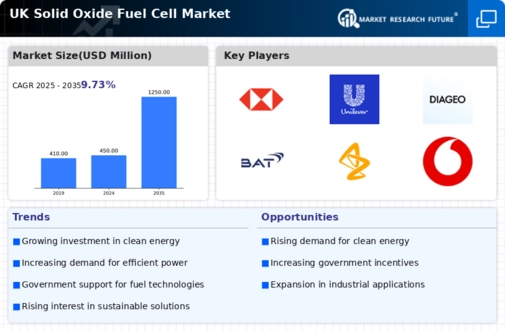Decarbonisation Efforts
The solid oxide-fuel-cell market is poised for growth as the UK intensifies its decarbonisation efforts. The government has committed to achieving net-zero greenhouse gas emissions by 2050, which necessitates a significant reduction in carbon emissions across all sectors. Solid oxide fuel cells, known for their high efficiency and low emissions, are increasingly viewed as a key technology in this transition. The market is projected to expand as industries seek to adopt cleaner technologies to meet regulatory requirements and consumer expectations. According to recent estimates, the solid oxide-fuel-cell market could see a compound annual growth rate (CAGR) of approximately 15% over the next five years, driven by the urgent need for sustainable energy solutions. This trend indicates a strong alignment between environmental goals and market opportunities.
Increasing Energy Security
The solid oxide-fuel-cell market is experiencing a notable surge in interest due to the increasing focus on energy security in the UK. As geopolitical tensions and supply chain vulnerabilities become more pronounced, the demand for reliable and independent energy sources is rising. Solid oxide fuel cells, with their ability to convert various fuels into electricity efficiently, present a viable solution. The UK government has set ambitious targets for energy independence, aiming for a 50% reduction in reliance on imported energy by 2030. This shift is likely to drive investments in solid oxide-fuel-cell technology, as businesses and consumers seek to enhance their energy resilience. Furthermore, the solid oxide-fuel-cell market is expected to benefit from the growing trend of decentralised energy systems, which align with the UK's energy security objectives.
Rising Industrial Applications
The solid oxide-fuel-cell market is witnessing a rise in industrial applications, which is likely to bolster its growth in the UK. Industries such as manufacturing, transportation, and power generation are increasingly exploring the use of solid oxide fuel cells for their energy needs. These cells offer advantages such as high efficiency and the ability to utilise a variety of fuels, including natural gas and biogas. The UK manufacturing sector, which contributes around £192 billion to the economy, is particularly interested in adopting cleaner technologies to enhance competitiveness and sustainability. As industries strive to reduce their carbon footprint, the solid oxide-fuel-cell market is expected to benefit from increased adoption in various industrial processes, potentially leading to a market expansion of over 20% by 2027.
Advancements in Research and Development
The solid oxide-fuel-cell market is being propelled by advancements in research and development (R&D) within the UK. Academic institutions and private companies are increasingly investing in innovative technologies to enhance the performance and reduce the costs of solid oxide fuel cells. Recent breakthroughs in materials science, such as the development of new electrolytes and catalysts, are expected to improve the efficiency and longevity of these fuel cells. The UK government has allocated substantial funding for clean energy R&D, which is likely to accelerate the commercialisation of advanced solid oxide fuel-cell technologies. This focus on innovation may lead to a more competitive market landscape, with new entrants and established players alike striving to capture market share. The potential for improved performance could result in a market growth rate of approximately 12% annually over the next few years.
Integration with Renewable Energy Sources
The solid oxide-fuel-cell market is increasingly integrating with renewable energy sources, which is likely to enhance its appeal in the UK. As the country aims to transition to a low-carbon economy, the synergy between solid oxide fuel cells and renewable energy technologies, such as solar and wind, is becoming more pronounced. These fuel cells can provide a stable and efficient means of energy storage and conversion, addressing the intermittency issues associated with renewable sources. The UK government has set a target of generating 70% of its electricity from renewable sources by 2030, which could drive demand for solid oxide fuel cells as a complementary technology. This integration may lead to a more resilient energy system, with the solid oxide-fuel-cell market projected to grow by approximately 18% as it aligns with the broader renewable energy goals.

















Leave a Comment